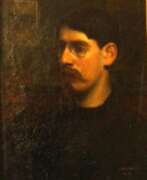Monks 20th century


Kim En Joong is a South Korean Dominican priest, painter, stained glass artist and renowned artist.
Representing abstract landscape painting, his non-figurative canvases, nourished by new technical notions of space and perspective, impose a change of scenery, the starting point of a quest for divine mystery.
In his pictorial works, what is striking is the impression of "liquidity" or "fluidity" of the pigments used. Thanks to delicate, pure and clear colours, Kim En Joong creates a fairytale-like spectacle by playing on the liveliness of the tones and the subtle contrasts.


Jan Verkade, birth name Johannes Sixtus Gerhardus Verkade, later changed to Willibrord Verkade, was a Dutch and German Benedictine monk, Post-Impressionist and Symbolist painter.
Jan was captivated by art from his youth and began studying painting at the State Academy of Fine Arts in Amsterdam, later in Paris he met Paul Gauguin, Paul Sérusier and other Symbolists, which played a major role in his worldview. In the last years of the 19th century, Verkade joined the Nabis (Les Nabis), a group of Symbolist artists. Fascinated by esoteric mysticism, the Kabbalah and Eastern magical teachings, he, however, adhered to the canons of Christianity.
In 1893 Verkade went to a Benedictine monastery in Boiron, Germany, painted churches and monasteries, and in 1902 he became a priest and changed his name to Willibrord Verkade. He continued to paint until 1927, but was no longer able to reach the level of his French period, considered his best period. However, he made a significant contribution to the Beuron school of art, which was founded by a confederation of Benedictine monks in Germany at the end of the 19th century. Up until his death in 1946, Verkade led a reclusive life, writing several religious, historical, and scientific linguistic works over the years.

